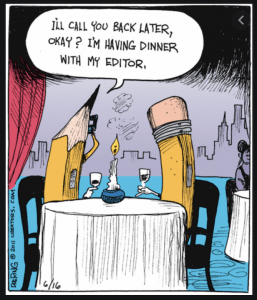 I had to answer this question for myself: “How true is my writing to me?”
I had to answer this question for myself: “How true is my writing to me?”
What does this mean? Put it another way; am I writing for me, or for others? The artist in me wants to write in my voice, my style. I want my writing to reflect my thinking—the way I see my world and how I connect dissimilar objects and events. Steve Jobs, of Apple fame, had a great ad campaign called, “Think Different“. That sums it up for me. I need to “Write Different” as an author. I must be true to myself and not have to copy another author. Yes, I should learn from others, but develop my own style. I cannot stand the works of Dan Brown, yet I learned from him. Great artists break established ways of doing things—that is how new styles develop in Art. Writing is no different. I am still learning, but getting closer to my own style. How do I define that style? Here’s an example. During a trip to Venice I saw a lady wearing a fur coat, yet I never came across any cats. I saw an immediate connection between cat and coat! Unrelated events can be connected through the imagination and it is through “thinking different” that I am learning to “write different”, with a sense of discovery and, yes, fun. I love writing funny stuff in thrillers! I just hope me readers enjoy this style too!
humor
John Grisham makes writing error, but does he need an online checker?
 From my own experience, I have enjoyed using online grammatical aids, to a point! Here’s my humble take on them:
From my own experience, I have enjoyed using online grammatical aids, to a point! Here’s my humble take on them:
+ve: picks up repeated phrases, checks sentence length, and overuse of adverbs, etc. Psst, here’s where it would have helped John Grisham in “The Guardians”—on page 157, he writes, “He takes a drink and studies the ocean.” Then, on page 159, John writes, “He takes a drink and studies the ocean.” Well, software would pick that up.
-ve: does not help you develop your own writing style, nor flow or ‘voice’. There is often a cost.
Ask yourself this question: would Hemingway, et al, use an online writing tool? They might in their early days of writing, but I am convinced they would go up the wall after a while and stay their own course through the rough editing waters. Good writing and editing software are destined to call off their romance after just a few dates!
The blur between fiction and non-fiction
Blog Views Mirror Thriller Plot?
The following graph is a summary of recent visitors to this blog.
 I could not help thinking that the rises and falls are similar to the intentional (or unintentional) rising and falling of tension in a thriller like 3 WISE MEN. For some, a sudden rise in tension – for example, the unexpected death of a character – is too much, and they prefer a more gentle building of tension. The steeper the graph, the more rapid the rise in the number of viewers on this blog. Peaks often correspond with holiday periods – a time when readers have more time to indulge in blogging. The mathematical significance of this graph would not be lost on our protagonist – Jak Colins! As a writer of thrillers, I am acutely aware of the need for the peaks and troughs in the plot. After all, I do want readers to be glued to the text and not easily able to put the book down. On the other hand, I know it is important to establish characters and event – something that might look like the trough in the graph above. For me, I need to work hard to do this characterization in a style that still engages, and a technique I have found useful is the use of humor. Let’s have a brief look at this in my next post.
I could not help thinking that the rises and falls are similar to the intentional (or unintentional) rising and falling of tension in a thriller like 3 WISE MEN. For some, a sudden rise in tension – for example, the unexpected death of a character – is too much, and they prefer a more gentle building of tension. The steeper the graph, the more rapid the rise in the number of viewers on this blog. Peaks often correspond with holiday periods – a time when readers have more time to indulge in blogging. The mathematical significance of this graph would not be lost on our protagonist – Jak Colins! As a writer of thrillers, I am acutely aware of the need for the peaks and troughs in the plot. After all, I do want readers to be glued to the text and not easily able to put the book down. On the other hand, I know it is important to establish characters and event – something that might look like the trough in the graph above. For me, I need to work hard to do this characterization in a style that still engages, and a technique I have found useful is the use of humor. Let’s have a brief look at this in my next post.
